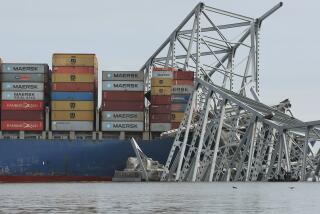USC professor advanced bridge building
- Share via
Ahmed M. Abdel-Ghaffar, a USC professor of engineering whose pioneering work in the design and monitoring of bridges led to the development of more efficient and reliable ways to build them, has died. He was 60.
Abdel-Ghaffar died April 17 at Torrance Memorial Medical Center from complications of liver disease, said his son Samy of San Francisco.
As a graduate student at Caltech in the early 1970s, Abdel-Ghaffar conducted seminal research on the Vincent Thomas Bridge, which links San Pedro to Terminal Island.
Through a state program, sensors had been placed on the bridge specifically to monitor the effects of a major earthquake. But Abdel-Ghaffar argued that streaming data from the sensors could be useful, even when there was no earthquake.
The sensors continuously measure lower-level vibrations -- such as those generated by wind and traffic -- that can cause subtle changes in the bridge. Abdel-Ghaffar collected the data and used them to create a mathematical model that represented the structural characteristics of the bridge, developing a picture of its overall health.
Such diagnostic information could then be used to design bridges that were better able to withstand earthquakes.
“At that time, 34 years ago, these ideas and this methodology were all very groundbreaking developments,” said Sami F. Masri, professor of civil and environmental engineering at USC. “This was not the conventional thing.”
Today, the use of sensors on bridges and other structures such as dams is widespread. The methodology that Abdel-Ghaffar pioneered applies to other structures as well, Masri said.
Abdel-Ghaffar’s work made him prominent in his field. Over the years, he consulted in the building of structures internationally, including the long-span bridge across the Gulf of Suez, an arm of the Red Sea between the bulk of Egypt and the Sinai Peninsula. He spent long periods in Japan, where he collaborated with bridge researchers at major universities.
The California Department of Transportation used a computer program Abdel-Ghaffar developed to retrofit the Vincent Thomas Bridge, Masri said.
In addition to his work with long-span bridges, Abdel-Ghaffar examined the interaction between soil and structures affected by earthquakes. He also conducted vibration experiments on Santa Felicia Dam, which forms Lake Piru in eastern Ventura County.
But bridges were his passion. Along with his students, he climbed the Golden Gate Bridge and collected data for a study on vibrations.
“He really loved bridges; he thought they were beautiful structures,” his son said.
Abdel-Ghaffar was born April 30, 1947, in Egypt, one of eight children. He received a bachelor’s degree in civil engineering from Cairo University.
At Caltech, he earned a master’s in civil engineering in 1973 and three years later a doctorate in civil engineering, with an emphasis on structural dynamics and earthquake engineering.
Abdel-Ghaffar began his academic career in 1978 with a brief stint at the University of Illinois. A year later, he joined the faculty of Princeton University, where he remained until moving in 1987 to the USC Sonny Astani Department of Civil and Environmental Engineering.
His journey from Cairo blazed a trail that others followed, his son said.
“He left a legacy at Cairo University,” Samy Abdel-Ghaffar said. “People found out that he was in America. He helped a lot of Egyptians come to the United States, and he was their PhD director, their mentor.”
In addition to Samy, Abdel-Ghaffar, who was divorced, is survived by another son, Tarek Abdel-Ghaffar of Torrance; a daughter, Sarah Abdel-Ghaffar of Los Angeles; and a brother and two sisters, who live in Egypt.
--
More to Read
Sign up for Essential California
The most important California stories and recommendations in your inbox every morning.
You may occasionally receive promotional content from the Los Angeles Times.












